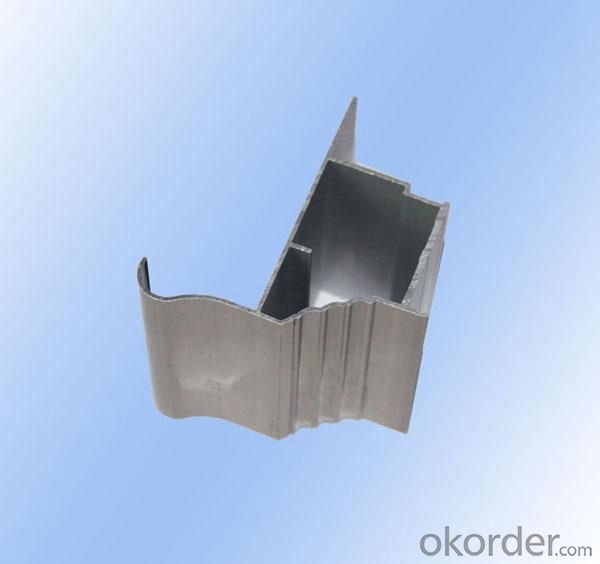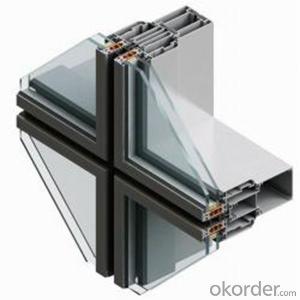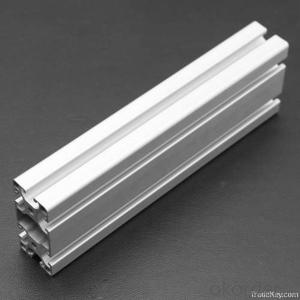Silver Finish Anodized Alloy Aluminum Profile for Glass Door Design
- Loading Port:
- Shanghai
- Payment Terms:
- TT OR LC
- Min Order Qty:
- 5 m.t.
- Supply Capability:
- 10000 m.t./month
OKorder Service Pledge
OKorder Financial Service
You Might Also Like
Item specifice
1. Specification of Silver Finish Anodized Alloy Aluminum Profile for Glass Door Design
Alloy | AA1050,AA1060, AA1070, AA1100 |
Temper: | H12, H14, H16, H18, H22, H24, H26, H32,HO, F |
Thickness: | 0.10-500mm |
Width: | 10mm- 2200mm |
Standard: | GB/T3880-2006, ASTM, ISO, EU standard |
Special Specification is available on customer’s requirement | |
2. Application of Silver Finish Anodized Alloy Aluminum Profile for Glass Door Design
wall cladding, ceilings, bathrooms, kitchens and balconies, shutters, doors,windows…
3. Feature of Silver Finish Anodized Alloy Aluminum Profile for Glass Door Design
Surface Quality :
Be free from Oil Stain, Dent, Inclusion, Scratches, Stain, Oxide Decoration, Breaks, Corrosion, Roll Marks, Dirt Streaks and other defect which will interfere with use,
Mochenical Property:
Chemical Composite and Mechanical Property
4. Certificate:
SGS and ROHS(if client request, paid by client), MTC(plant provided), Certificate of Origin(FORM A, FORM E, CO), Bureau Veritas and SGS (if client request, paid by client), CIQS certificate
5. Image of Silver Finish Anodized Alloy Aluminum Profile for Glass Door Design



6. Package and shipping of Silver Finish Anodized Alloy Aluminum Profile for Glass Door Design
First, plastic cloth with drying agent inside; Second, Pearl Wool; Third, wooden cases with dry agent, fumigation wooden pallets, aluminum surface could cover blue PVC film
7. FAQ
Question 1: What is your MOQ?
We accept one ton per type for an order. But the detail we could negotiate.
Question 2: What is your normal terms of payment?
We always trade with you by T/T. But we also accept the L/C as you require.
Question 3: How many kinds of the surface treatment we can choose?
You could choose different color of powder coated. Anodized of black. matte silver, nature, champagne, bronze color. Mill finished. Wooden finished and printed.etc.
Question 4: Can you supply OEM services?
We offer OEM services for 17 years.
Question 5: How many days for opening the mould?
Normally about 10 days.According to the difficulty of your drawing.
Question 6: Can i choose the package what i want?
Yes, of course. We offer various kinds of package.e.g.PE foam. Shrink film. Wrapping paper.
But we would give you professional suggestion of package.
- Q:Are aluminum profiles resistant to impact or vibration?
- Yes, aluminum profiles are generally resistant to both impact and vibration. Aluminum is known for its high strength-to-weight ratio and excellent durability. It can withstand external forces and impacts without easily deforming or breaking. Additionally, aluminum's natural properties make it inherently resistant to vibration. It has a high damping capacity, meaning it can absorb and dissipate vibrations, reducing their effects. This makes aluminum profiles an ideal choice for applications where impact or vibration resistance is required, such as in the construction, automotive, aerospace, and marine industries.
- Q:Can aluminum profiles be used in the production of audiovisual equipment?
- Yes, aluminum profiles can be used in the production of audiovisual equipment. Aluminum is a lightweight and durable material that can be easily molded into various shapes and designs. It offers excellent heat dissipation properties and is resistant to corrosion, making it suitable for audiovisual equipment such as speaker stands, camera mounts, and TV brackets. Additionally, aluminum profiles can be customized to fit specific requirements, providing flexibility in design and construction.
- Q:How do aluminum profiles perform in terms of water resistance?
- Aluminum profiles generally exhibit high water resistance due to their natural corrosion resistance and the protective oxide layer formed on their surface. This makes them highly suitable for applications exposed to water or high humidity environments. However, the performance can also depend on the specific alloy and surface treatment used.
- Q:What are the different surface finishing options available for aluminum profiles?
- Some of the different surface finishing options available for aluminum profiles include anodizing, powder coating, painting, polishing, and brushing. Each option offers a unique aesthetic and protective properties, allowing for customization and durability in various applications.
- Q:What are the different sealing options for aluminum profiles?
- There are several sealing options available for aluminum profiles, including anodizing, powder coating, liquid paint coating, and mechanical sealing. Anodizing is a popular choice, providing a durable and corrosion-resistant finish by creating a protective oxide layer on the surface of the aluminum. Powder coating involves applying a dry powder to the profile, which is then cured under heat to form a hard, smooth coating. Liquid paint coating can also be used, offering various colors and finishes, but may require more maintenance. Mechanical sealing involves using gaskets, tapes, or other sealing materials to create a tight seal between aluminum profiles. The choice of sealing option depends on the specific requirements of the application, such as desired aesthetics, durability, and environmental factors.
- Q:Can aluminum profiles be used in lightweight construction applications?
- Aluminum profiles are definitely applicable in lightweight construction. They possess a lightweight and versatile nature that brings numerous advantages to construction projects. With a high strength-to-weight ratio, structures can be built with less material yet still maintain strength and durability. This makes aluminum profiles an ideal choice for lightweight construction where weight reduction is crucial. Various construction projects, including building facades, interior partitions, roofing systems, and structural frameworks, commonly utilize aluminum profiles. They are particularly favored in industries such as aerospace, automotive, and marine where reducing weight is of utmost importance. Additionally, aluminum profiles exhibit excellent resistance to corrosion, making them suitable for outdoor and high-moisture environments. Their high malleability allows for easy fabrication into different shapes and sizes, enabling customized designs and simple installation. Moreover, aluminum is an eco-friendly material as it can be recycled infinitely without compromising its properties. To sum up, the widespread use of aluminum profiles in lightweight construction stems from their lightweight nature, strength, durability, corrosion resistance, malleability, and environmental benefits.
- Q:Are aluminum profiles suitable for material handling equipment?
- Material handling equipment can benefit greatly from the use of aluminum profiles. These profiles offer numerous advantages that make them an excellent choice for such applications. To begin with, aluminum is both lightweight and strong, making it easy to handle and transport materials. This is particularly advantageous for equipment that requires frequent maneuvering or transportation. Furthermore, aluminum profiles possess remarkable corrosion resistance properties, rendering them suitable for both indoor and outdoor material handling tasks. This durability ensures that the equipment can withstand harsh environments and maintain its structural integrity over time. In addition, aluminum profiles can be easily customized and assembled to create a wide range of material handling equipment, including carts, conveyors, and shelving systems. The versatility of these profiles allows for flexibility in design and adaptability to various material handling requirements. Moreover, aluminum is a sustainable material as it can be fully recycled. Opting for aluminum profiles for material handling equipment aligns with environmentally friendly practices and helps reduce the carbon footprint. In conclusion, aluminum profiles are indeed well-suited for material handling equipment due to their lightweight yet strong nature, corrosion resistance, design versatility, and sustainability.
- Q:Can aluminum profiles be custom-designed or customized?
- Yes, aluminum profiles can be custom-designed or customized according to specific requirements and specifications. This flexibility allows them to be tailored to various applications and industries, providing a wide range of options for individual needs.
- Q:What are the advantages of using aluminum profiles in transportation vehicles?
- Using aluminum profiles in transportation vehicles offers several benefits. To begin with, aluminum is lighter than other metals like steel. This results in reduced fuel consumption and increased energy efficiency, making it perfect for vehicles that require frequent movement and long distances. Moreover, the lightweight nature of aluminum improves maneuverability and handling, enhancing overall vehicle performance. Secondly, aluminum profiles provide excellent corrosion resistance. This is especially important for transportation vehicles that face harsh weather conditions and corrosive elements like salt and moisture. Aluminum's corrosion resistance ensures the vehicle's longevity and durability, reducing maintenance and repair costs. Additionally, aluminum profiles are highly recyclable. The recycling process for aluminum requires less energy compared to producing primary aluminum. This not only reduces greenhouse gas emissions but also contributes to the sustainability of the transportation industry. Aluminum's recyclability aligns with the growing focus on eco-friendly practices. Furthermore, aluminum profiles offer great design flexibility. They can be easily extruded into various shapes and sizes, allowing manufacturers to create customized components and structures for transportation vehicles. This flexibility optimizes space and weight distribution, resulting in improved efficiency and functionality. Lastly, aluminum profiles are non-toxic and non-magnetic. This is advantageous in transportation vehicles as it eliminates the risk of interference with sensitive electronic systems and equipment. Aluminum's non-toxic nature also makes it a safe choice for transporting food and other sensitive materials. In conclusion, there are numerous advantages to using aluminum profiles in transportation vehicles. Its lightweight, corrosion resistance, recyclability, design flexibility, and non-toxic properties make it an ideal material for enhancing fuel efficiency, durability, sustainability, and overall performance in the transportation industry.
- Q:Can aluminum profiles be used in the manufacturing of furniture?
- Yes, aluminum profiles can be used in the manufacturing of furniture. Aluminum is a versatile and lightweight material that offers several advantages for furniture production. It is highly durable, resistant to corrosion, and has a high strength-to-weight ratio. These properties make it suitable for various furniture applications, including chairs, tables, shelving units, and frames. Additionally, aluminum profiles can be easily customized, allowing for the creation of unique and modern designs. The use of aluminum in furniture manufacturing also contributes to sustainability, as it is a recyclable material. Overall, aluminum profiles provide designers and manufacturers with flexibility and durability, making them a popular choice in the furniture industry.
1. Manufacturer Overview |
|
|---|---|
| Location | |
| Year Established | |
| Annual Output Value | |
| Main Markets | |
| Company Certifications | |
2. Manufacturer Certificates |
|
|---|---|
| a) Certification Name | |
| Range | |
| Reference | |
| Validity Period | |
3. Manufacturer Capability |
|
|---|---|
| a)Trade Capacity | |
| Nearest Port | |
| Export Percentage | |
| No.of Employees in Trade Department | |
| Language Spoken: | |
| b)Factory Information | |
| Factory Size: | |
| No. of Production Lines | |
| Contract Manufacturing | |
| Product Price Range | |
Send your message to us
Silver Finish Anodized Alloy Aluminum Profile for Glass Door Design
- Loading Port:
- Shanghai
- Payment Terms:
- TT OR LC
- Min Order Qty:
- 5 m.t.
- Supply Capability:
- 10000 m.t./month
OKorder Service Pledge
OKorder Financial Service
Similar products
New products
Hot products
Hot Searches
Related keywords






























